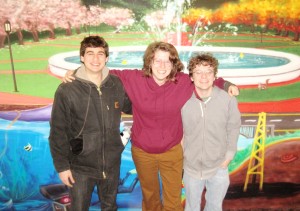During the first meeting of the new quarter, our lab meeting consisted of each member talking about what they did this summer: be it professional achievement or a personal one. We laughed together. We ate pizza and a root vegetable medley made by one of the students, as per last year’s tradition to share food during meetings which had to be during mealtimes due to our excessively overwhelming schedules. We applauded for especially noteworthy remarks, such as: making a plan to graduate soon (2x), submitting a paper to the most recent Big Deal Conference deadline (4x), getting married (1x),and managing to have an actual honest-to-goodness vacation (3x). In our meetings for the last few years, we have allowed the unrelated to seep in, and I think it has improved both the variety and the caliber of our work. Instead of seeing these asides as distractions, we engaged with each other about a huge variety of research topics, as well as human topics.
In my own multi-year struggle with work-life balance (aka, “four years of grad school”), I have found it useful to have one core assumption. Even though I work on a million of seemingly-unrelated projects, they are necessarily and fundamentally related: because they are mine, and are built on the same body of knowledge. In this sense, every intellectually-stimulating conversation that grabs my attention is, by definition, relevant. It is relevant to my perception of the world, and I take note of it. Incidentally, when I began to pursue this sense of “wholeness,” it helped to ease the dreaded (and all-too-common) “impostor syndrome,” the haunting sense of being found out as far less competent than I appear. On the one hand, yes, with anything that I do, there are many people in the world who are much better at that thing than I am. But they are all not me, they do not have the combined idiosyncratic background I bring to the table: the whole has more creative variety to draw from than the sum of its parts. So I can feel both more secure in myself, and relieved that there is always someone to save you from excruciating (and boring) intellectual solitude with advice, feedback, and debate.
“How did you get over anxiety during giving talks?” one of the students asked Cecilia in an aside in a meeting a few years ago. “Well, when you’ve flown a plane straight at the ground at 250 mph at an airshow with hundreds of thousands of people watching, it’s difficult to be too stressed out about other things.” Professor Aragon leads our lab, teaches classes, and occasionally shares what she learned from the time she was an aerobatic champion. Instead of viewing “work life balance” as something of a separation between our “work” selves and our “life” selves, we’re building empathy within the group, as well as sharing with one another our wonderful variety of experiences and lessons.


![Different codes benefit from different kinds of features [1]](http://students.washington.edu/kuksenok/blog/wp-content/uploads/2012/12/predictive_features_cscw2013-150x150.png)


